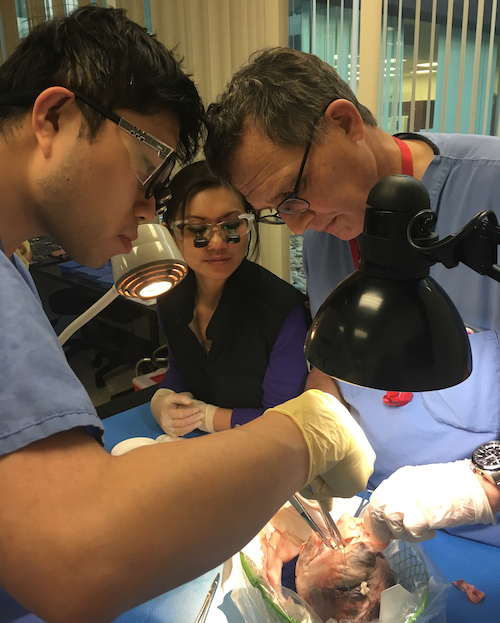The Cardiothoracic Surgery Division involves the care of adult cardiac and general thoracic surgery patients. Residents spend blocks of time rotating on both clinical services provided by the Division, which together involve the care of adult cardiac and general thoracic surgery patients. The Division’s faculty performs over 500 adult open-heart procedures and 150 adult thoracic procedures annually. Thus, our residents are introduced to the whole spectrum of cardiothoracic surgery.
The cardiac experience includes off- and on-pump/minimally invasive/robotic coronary artery bypass grafting, minimally invasive valve replacement and repair, arrhythmia surgery, and endovascular and open aortic surgery. The general thoracic experience encompasses benign and malignant disease of the lung, esophagus, and chest wall. Second-, third-, and fourth-year residents participate in these operations, and help run University Hospital's 10-bed cardiothoracic intensive care unit.
The aim of the general surgery resident rotations on the cardiothoracic service is to formulate a solid foundation in cardiopulmonary physiology and medicine, to learn and perform thoracic surgical incisions, to develop a practiced understanding of vascular surgical principles, and to gain confidence when working around the heart and great vessels, particularly in trauma situations. Ample opportunity is afforded to gain experience with and understanding of the latest technologies used in cardiothoracic surgery.
As the cardiothoracic surgery service involves the care of adult cardiac and general thoracic surgery patients, the full spectrum of acquired and congenital adult cardiac pathology is covered including coronary artery disease, valve disease, aortic disease, electrophysiology, and pericardial disease. In the realm of general thoracic surgery, benign lung disease, lung cancer, esophageal, mediastinal and chest wall pathology are encountered.

The resident team rotating on the cardiothoracic surgery service works closely with our nurse practitioners and physician assistants. Over the years from PGY-2 through PGY-4, there is a gradual increase in responsibility for management of the service. Residents run the daily interdisciplinary morning rounds in the cardiothoracic intensive care unit. They are responsible for management of the postoperative cardiothoracic patient. They see consults in the emergency room and on the wards.
Residents do increasingly complex procedures, starting from central lines and thoracentesis to chest tubes, sternotomy and chest closure and emergent open chests. They participate in all general thoracic cases. They present articles at our bimonthly journal club, participate in our weekly morbidity and mortality conference and attend our weekly didactic lectures. We have many medical students on our service whom they mentor.
Resident participation in the Division’s research programs on a formal or informal basis is encouraged, and several residents have presented their findings at national meetings. The Division’s growing programs in basic/translational research afford increased opportunities for our trainees to gain research experience at the highest level.

